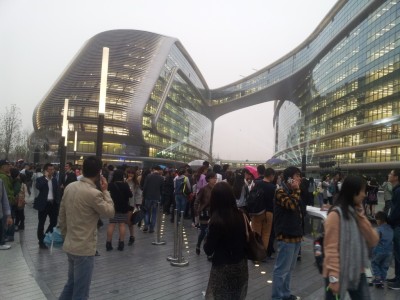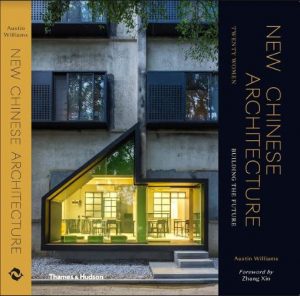In defence of a Defence of Stars and Icons
 Austin Williams | 20 April 2015
Austin Williams | 20 April 2015
It is a sad indictment of current architectural debate (as well as critical political debate more generally) that Patrik Schumacher’s latest article is creating such a fuss. Fans of Walter Benjamin – the unread darling of the Situationist mainstream – wouldn’t dream of criticising his statement “The public must always be proved wrong, yet always feel represented by the critic” (Walter Benjamin, One-Way Street and other writings, Suhrkamp Verag, Frankfurt, 1970). And yet, Schumacher has drawn the vitriol of the same ilk for saying the same thing. It emphasises his point that commentators are seldom really engaged in the debate, but create their own position from which they hurl condemnation at those they believe to be opposed to the orthodoxy.
 In this way, post facto, the debate around Schumacher’s latest polemic “On the Denunciation of Architectural Iconography” (see below) explains why it had to be written in the first place. It poses a simple challenge: why is it so difficult to understand the need for authority – for expertise, for ranking, for leadership, for a canon – amongst architects (surely a profession of privileged experts)?
In this way, post facto, the debate around Schumacher’s latest polemic “On the Denunciation of Architectural Iconography” (see below) explains why it had to be written in the first place. It poses a simple challenge: why is it so difficult to understand the need for authority – for expertise, for ranking, for leadership, for a canon – amongst architects (surely a profession of privileged experts)?
The recognition of an elite is not the same as arguing for a cabal or clerisy of untouchable designers; nor is it arguing that everyone should agree with Schumacher’s argument. While some might bemoan the patrician or pompous attitude that professionalism generates in some architects, sometimes the critical approach is simply sour grapes. Undoubtedly, those less-abled architects who are not part of the architectural establishment may like to pretend that they represent “the 99%” – the aggrieved, hard-done by majority of architects – but they have no mandate to do so. They prefer to shout down those views they dislike precisely because they cannot express their political disagreement with the Schumacher’s position or his architectural vision. As the art critic Robert Hughes once noted “when an artist says that I am conservative, it means that I haven’t praised him recently.”
The second point under discussion is the realisation that architectural “professionalism”, by definition, separates the creative designer from the public he or she serves (as pointed out in the Benjamin quote above). Many architects need to have their designs translated in architectural terms as well as into journalese (and obviously also into PR terms). These are usually distinct agendas (one complex, one simplified) but both regularly get confused. Undoubtedly over-intellectualised architectural obfuscation (sic) isn’t helpful and can lead to rather inaccessible texts but actually sometimes big ideas are not meant to be simplified too much. However, the opposite tendency is more insidious whereby the intellectual laziness of academia is exposed in the contemporary clamour for a “public-facing knowledge industry”. Here, architectural critique comes across as a populist while actually patronising the intelligent reading public.
On the other hand, unprofessional journalistic bias is also undermining useful, thorough critique. The journalist’s role is understanding the architecture, clarifying the designers intent, explaining the concepts, complexity and success (or failure), provide a position, offer a knowledgeable critique: it is a skill no less challenging than the work under consideration. Harold Bloom said that “Criticism is a genre of literature”.
As such, there is a journalistic (not merely an “architectural journalistic”) need to take constructed ideas, built form, to task. This should be non-sycophantic but equally it needs to be non-partisan. It needs to be fair rather than poisonous. It needs to critique rather than merely criticise or condemn. The various articles on this subject (especially this example at Archinect) come at the subject with a predisposition to take sides. It masquerades as critique but actually mis-represents – wilfully or otherwise – the actual words of the debate/article. Such vindictiveness suggests perhaps that Schumacher has a point in arguing the need for an authoritative critical literary voice to be able to assess intelligently, to create an acceptable climate of debate on these subjects. At the moment, criticising architecture for being “iconic” is deemed to be an insult, rather than a self-fulfilling truism arising from the debate.
We need a more journalistic nuance as well as hard-hitting intelligent critique. The debate needs to assess the merits – the earned legitimacy – of iconic status as well as be able to simply understand what is good and bad architecture.
Read for yourself:
 THE DENUNCIATION OF ARCHITECTURAL ICONS AND STARS IS ITSELF SUPERFICIAL AND IGNORANT !
THE DENUNCIATION OF ARCHITECTURAL ICONS AND STARS IS ITSELF SUPERFICIAL AND IGNORANT !
by Patrik Schumacher
To criticize iconic buildings and the hype around star-architects as superficial is an all-to-easy point-scoring which indeed usually misses the point. Dismissive critics – the Woodmans of this world who seem to relish the more in their condescension, the more the reputation of the object of their condescension has grown should perhaps slow down a bit in their (pre-)judgement and reflect on their role as mediators between the discourse of architecture and the interested public. Rather than seeing conspicuity and success merely as a red cloth and occasion to knock down icons (and to teach the virtues of the ordinary, obscure and underappreciated) it should perhaps be the task of critics to first of all explicate the reputations and inspirational works that command the attention of the discipline and the public. Explanation rather than dismissal and substitution should be seen as the critics’ task. In what follows I would like to indicate some heuristic principles which might guide this task of explanation.
In order to make sense of iconic architecture it is helpful to begin with the distinction between the architectural discourse among architects and the discourse of architectural critics addressed to the general public. The idea of iconic architecture is a product of the critics’ discourse that plays no role in the architects’ discourse. The idea of iconic architecture serves the purpose of filling the explanatory gap that inevitably opens up because the methodology and motivation behind the unusual appearance of a radically innovative design cannot be fully explained to the general public. However, the in-depth reasoning behind these designs can indeed be explained and this is the subject of architectural discourse proper. (What needs also to be explained is that original innovations are sometimes more pointers to future possibilities – calling for a measure of strategic tolerance – rather than fully fleshed out achievements that are already in all respects fully competitive.) The mediation of aspects of this more in-depth explanation would be the critic’s task.
The conspicuous, memorable visual appearance of an avant-garde design is an inevitable by-product or side-effect of the new approach taken by the avant-garde architect rather than the aim of the design effort. This is certainly the attitude we take at Zaha Hadid Architects. For instance, it is often our ambition to adapt the shape of our buildings to the complex site conditions they are meant to address. Further, we are often dealing with complex programmatic arrangements that might call for an internal intensity of relations. Our methodology involves the use of distortions, curvature and gradients, respectively in order to adapt to irregular sites, maintain legibility in the face of complex interrelations, and to articulate connections and transitions. The result is often visually surprising and stimulating. But we never aim to create an icon. Our buildings become icons, temporarily, until our methodology and style becomes more widespread.
The general public is often trying to make sense of these strange, abstract spatial creations by way of giving them a figural reading, as if these designs were metaphors for dragons, snakes or flames etc. We are always trying hard to pre-empt such figurative reading by changing the design as soon as such allusions suggest themselves. What can never be avoided, however, is that the building is misunderstood as aiming for iconicity.
The side-effect of innovative work, i.e. the stimulating strangeness and sometimes the figurative suggestiveness of avant-garde buildings, becomes a values in itself. Iconicity becomes a value sought after by clients. This in itself is not bad. It is indeed the only way clients intuit an innovative thrust. However, at this stage superficial epigones might enter the scene trying to exploit the taste for icons. We have witnessed some of this in Dubai and China where plentiful resources were not always matched by a sufficiently developed ability to discriminate between serious, original work and superficial spectacles. It is this phenomenon which flourished in the run up to the 2008 crash and that thereafter led many critics and architects to denounce iconicity as frivolous and wasteful. However, these dismissals should not touch us at Zaha Hadid Architects. We never aimed for superficial iconicity and the value of our work does not depend on becoming a spectacle.
The star-system can be analysed and explained in parallel to the phenomenon of iconic architecture. Architectural stars are a creation of critics and the mass media. They exist for the general public rather than for the architects’ discourse. Just like radical architectural innovation translates into iconicity for the general public, in a related move, the architectural reputations gained within the discipline on the basis of innovative, influential work, eventually translate into mass media stardom for public consumption. Again this is not inherently problematic. It is inevitable that the results of the disciplinary process of reputation formation – if it should be transmitted into general knowledge at all – must go along with a certain loss of information, namely the expert information about how and why this or that preeminent reputation was gained.
The star system indeed complements the idea of iconic architecture as it is the only way clients can re-assure themselves against falling prey to the superficial, short-lived spectacles of the charlatan epigones. The star-system thus functions very similar to the system of brands in general. The name of an architectural star becomes a trusted brand. It serves as a substitute for an in depth analysis, evaluation and testing of the product. The evaluation of a large new complex building is too difficult, especially under the contemporary condition of permanent innovation. The star-system offers an alternative. This substitution is viable because the reputations the star-system is building on have emerged in a long, competitive process of peer selection. That the stardom of star architects, as it circulates in the mass media, is superficial is a necessary effect of the translation process. Complexity reduction is necessary. Only a few names become visible and as a result these names get perhaps an undue share of the overall work opportunities. Their worthiness remains unexplained, becomes a dogma. Therefore they might stay in the game perhaps a little longer than is merited, while younger talent remains obscure for longer than they should. But these inevitable shortcomings do not invalidate the essential rationality of the star-system as explicated above.
Due to its inevitable superficiality, the star-system becomes an easy prey for well-informed, eloquent critics, as well as for enviously on-looking architects who feel they deserve as much attention and work as the stars and perhaps become resentful. The resultant star bashing is problematic and ultimately unproductive. The stars became stars for good reasons and they have to perform to remain on top. Like brands in general, they cannot easily be dispensed with in our increasingly complex world. They condense necessary information and thus reduce uncertainty.
To conclude:
Iconic architecture and the star-system are both creatures of the architectural critic (rather than creatures of architecture itself) who plays the role of a mediator between the expert architectural discourse on the one hand and the mass media on the other hand. They communicate relevant news from the world of architecture to potential clients, customers and the general public. But architectural stars and iconic buildings are not created ex nihilo by the critics’ Midas’ touch. The critics only distil what the expert discourse among architects and architectural theorists has already selected and confirmed through a proliferating influence within the discipline. Promoted by the mass media’s architectural critics, the star-system and iconic architecture work hand in hand, and both are here to stay as necessary mediations that convey the most important reputations and innovations to society at large. The critics have no choice but to trade in stars and icons, because their audiences need to know and they can learn what they need to know in no other way. However, the foregrounding of the underlying innovative possibilities and the (if sometimes only partial) rationality of the stars’ oeuvre could be attempted as a worthy task for the critics’ informed intelligence and eloquence.
Finally, I would like to give a further hint about the potential of iconicity, without having space here to elaborate. Elsewhere I have written about the instrumentality of appearances, information-rich environments, the built environment as semiological system and about the inevitability of navigating the environment (and indeed the social world in general) on the basis of aesthetic appeal and repulsion. Iconicity plays a role in all these aspects.”
P. Schumacher






